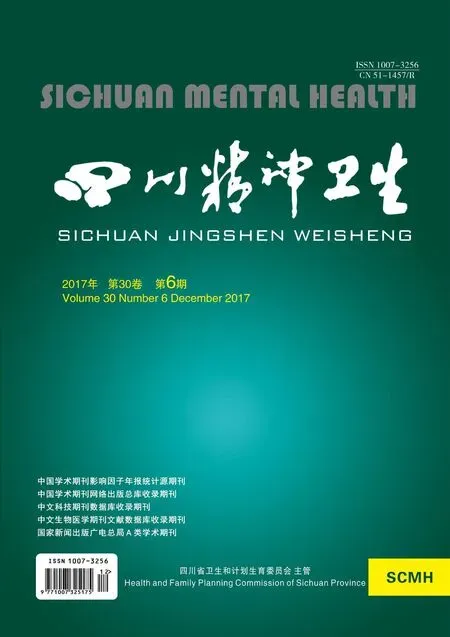阿立哌唑对精神分裂症患者人际知觉功能的影响
罗 瑜,江晨光,周振和,赵幸福,贺 文
(南京医科大学附属无锡精神卫生中心,江苏 无锡 214151*通信作者:贺 文,E-mail:1091867081@qq.com)
论著·临床
阿立哌唑对精神分裂症患者人际知觉功能的影响
罗 瑜,江晨光,周振和,赵幸福,贺 文*
(南京医科大学附属无锡精神卫生中心,江苏 无锡 214151*通信作者:贺 文,E-mail:1091867081@qq.com)
目的探讨阿立哌唑在改善精神分裂症患者人际认知功能上的优势。方法将符合《精神障碍诊断与统计手册(第5版)》(DSM-5)精神分裂症诊断标准的60例患者随机分为阿立哌唑治疗组和氟哌啶醇治疗组各30组,同期选择30名健康人作为对照组。于基线期、治疗4周后及12周后对两患者组进行人际知觉任务(IPT-15)、阳性和阴性症状量表(PANSS)评定,对照组在基线期接受IPT-15评定。结果阿立哌唑组与氟哌啶醇组PANSS总评分及各因子评分均随治疗时间延长而降低(P均<0.05),但各时间节点上两组比较差异均无统计学意义(P均>0.05)。治疗前,阿立哌唑组与氟哌啶醇组IPT-15总评分及各因子评分均低于对照组(P均<0.05);治疗后,阿立哌唑组与氟哌啶醇组IPT-15评分治疗时间节点(基线期、4周以及12周)主效应显著(P<0.05),治疗时间节点×组别交互作用显著(P<0.05)。治疗12周末,阿立哌唑组与氟哌啶醇组IPT-15总评分及各因子评分比较差异均有统计学意义(P均<0.05)。结论精神分裂症患者存在人际知觉功能缺陷,阿立哌唑可能有助于改善其人际知觉功能。
精神分裂症;阿立哌唑;氟哌啶醇;人际知觉任务
*Correspondingauthor:HeWen,E-mail:1091867081@qq.com)
精神分裂症是一种常见的精神疾病,大多发病于成年早期,主要表现为感知觉、情感反应及意志行为方面的异常。阳性症状、阴性症状、情感症状、认知症状以及攻击行为是精神分裂症的主要症状。认知包括神经认知功能、情绪认知以及社会认知功能[1-4]。目前,对精神分裂症患者神经认知及情绪认知的研究相对较多,但针对社会认知的研究相对较少。社会认知是一种分析和理解社会心理现象的能力,包含了对社会、情感刺激因素的感知和判断,以及对行为和人际关系的认知过程。已有研究表明,精神分裂症患者存在社会认知缺陷,且社会认知功能的改善程度与整体预后有关[5-7]。人际知觉功能是反映社会认知功能的重要成分,是指对人与人之间关系的知觉能力,包括对人的外部特征、个性特点和行为的理解和判断的能力。精神分裂症的治疗多以药物治疗为主,由于药理学机制的差异,在改善认知功能方面,第二代抗精神病药物相对于第一代抗精神病药物具有一定的优势,但两代药物对患者社会认知功能的影响有何差异,至今鲜有报道。本研究假设第二代抗精神病药物比第一代抗精神病药物能更好地改善精神分裂症患者的社会认知功能。为进一步了解不同抗精神病药物对社会认知功能的影响情况,本研究比较阿立哌唑和氟哌啶醇在治疗精神分裂症时对患者人际知觉功能的影响差异。
1 对象与方法
1.1 对象
所有患者来源于2014年10月-2017年2月在南京医科大学附属无锡精神卫生中心住院的患者。入组标准:①符合《精神障碍诊断与统计手册(第5版)》(Diagnostic and Statistical Manual of Mental Disorders, fifth edition,DSM-5)精神分裂症诊断标准;②年龄≥18岁;③2周内未使用过任何药物;④知情同意合作者。排除标准:①目前或既往患有精神分裂症之外的精神疾病者;②有重大躯体疾病者。符合入组标准且不符合排除标准共60例,采用随机数字表法分为阿立哌唑组和氟哌啶醇组各30例。由2名精神科医师对入组患者进行精神分裂症的一致性诊断。同期在本院工作人员中选择30名健康人作为对照组。入组标准:①年龄≥18岁;②无精神疾病家族史;③知情同意合作者。排除标准:①目前或既往患有精神疾病者;②有重大躯体疾病者。本研究通过南京医科大学附属无锡精神卫生中心伦理委员会批准。
1.2 治疗方法
阿立哌唑组接受阿立哌唑口腔崩解片(博思清,成都康弘药业集团股份有限公司,141009)治疗,起始剂量10 mg/d,根据病情逐步加量,最高剂量为30 mg/d。氟哌啶醇组接受氟哌啶醇片(氟哌啶醇片,宁波大红鹰药业股份有限公司,140506)治疗,起始剂量4~6 mg/d,根据病情逐步加量,最高剂量为40 mg/d。两种药物均在2周内调整至目标剂量。经过4周治疗后,阿立哌唑组所用阿立哌唑剂量为(25.6±4.5)mg/d,氟哌啶醇组所用氟哌啶醇剂量为(22.8±5.0)mg/d。
1.3 评定方法
于治疗前、治疗4周和12周后采用阳性和阴性症状量表(Positive and Negative Syndrome Scale,PANSS)评定患者组病情严重程度。PANSS共30个条目,包括阳性量表7项、阴性量表7项、一般精神病理量表16项,均采用1~7分7级评分,评分越高表明症状越严重。PANSS评定统一由一名高年资精神科医师完成,在患者所在病房安静的会客室进行,每次评定耗时约30~50 min。
于治疗前、治疗4周和12周后采用人际知觉任务(Interpersonal Perception Task-15,IPT-15)评定患者组人际知觉功能,对照组仅在入组时接受IPT-15评定。IPT-15测验通过播放一个时长20 min包含15个自然场景的短片,短片内容可分为反映亲情关系、亲密程度、欺骗关系、竞争关系和从属关系5个类别,每个类别有3个场景,每个场景持续28~122秒不等,出现1~4个角色。受试者看完短片后根据提问给出答案。IPT-15测验均由同一名精神科医生负责,每次测试约需25 min(含指导语),在患者所在病房的示教室进行,测试时确保周围环境安静。
1.4 统计方法

2 结 果
2.1 基本特征
共有98例患者接受筛查,其中32例因不符合入组标准被排除,另有6例符合入组标准者因其他原因未纳入,最终入组患者人数为60例,采用随机数字表法随机分为阿立哌唑组和氟哌啶醇组各30例;同期招募30名健康被试作为对照组。患者组所有被试均顺利完成本项研究,无脱落。见图1。
阿立哌唑组男性16例(53.3%),女性14例(46.7%),年龄18~53岁,平均年龄(38±13)岁,平均受教育年限(8±3)年,平均病程(5±2)年;氟哌啶醇组男性17例(56.7%),女性13例(43.3%),年龄19~52岁,平均年龄(38±14)岁,平均受教育年限(8±3)年,平均病程(5±2)年;对照组男性15例(50.0%),女性15例(50.0%),年龄(18~52)岁,平均年龄(38±14)岁,平均受教育年限(9±3)年。

图1 研究流程图
2.2 两组PANSS评分比较
以治疗时间节点(基线期、治疗4周、12周后)为组内因素,以治疗时间节点×组别(阿立哌唑组与氟哌啶醇组)为组间因素的重复测量方差分析显示,治疗时间节点主效应显著(PANSS总评分:F=397,df=2,P<0.01;阳性症状量表评分:F=245,df=2,P<0.01;阴性症状量表评分:F=201,df=2,P<0.01;精神病理症状分量表评分:F=160,df=2,P<0.01),两组PANSS总评分及各因子评分均随治疗时间的延长而降低。但治疗时间节点×组别交互作用不显著(F=1.502,df=2,P=0.190),两组PANSS评分及各因子评分在各治疗时间点上差异均无统计学意义。见表1。
2.3 三组IPT-15评分比较
分别以亲情关系、亲密程度、欺骗关系、竞争关系、从属关系以及IPT-15总评分为因变量的单因素方差分析显示,组别(阿立哌唑组、氟哌啶醇组与对照组)主效应显著(F=32.7,df=2,P<0.01)。阿立哌唑组和氟哌啶醇组IPT-15总评分及各因子评分均低于对照组(P均<0.01),阿立哌唑组和氟哌啶醇组IPT-15总评分及各因子评分差异无统计学意义(P=0.643)。
以治疗时间节点(基线期、治疗4周、12周后)为组内因素,以治疗时间节点×组别(阿立哌唑组与氟哌啶醇组)为组间因素的重复测量方差分析显示,治疗时间节点主效应显著(亲情关系:F=25.6,df=2,P<0.01;亲密程度:F=25.0,df=2,P<0.01;欺骗关系:F=22.4,df=2,P<0.01;竞争关系:F=22.9,df=2,P<0.01;从属关系:F=29.7,df=2,P<0.01;总评分:F=210,df=2,P<0.01),同时显示治疗时间节点×组别交互作用显著(F=5.4,df=2,P<0.01)。
多因素方差分析显示,阿立哌唑组与氟哌啶醇组IPT-15总评分及各因子评分在治疗4周末差异无统计学意义(F=0.80,df=1,P=0.112),在治疗12周末差异有统计学意义(F=13.0,df=1,P<0.01)。见表2。

表1 阿立哌唑组与氟哌啶醇组PANSS评分比较分)
注:PANSS,阳性和阴性症状量表

表2 阿立哌唑组、氟哌啶醇组与对照组IPT-15评分比较分)
注:IPT-15,人际知觉任务
3 讨 论
已有研究表明,第二代抗精神病药物对精神分裂症患者认知功能的改善作用可能优于第一代抗精神病药物[8]。社会认知功能作为认知功能中最高级的心理过程,抗精神病药物对其影响如何,尚存在争议[9]。Littrell等[10]采用IPT测验结果显示,接受奥氮平治疗的患者其社会认知功能改善程度优于使用传统抗精神病药物治疗者;而Kucharska-Pietura等[11]以慢性精神分裂症患者为对象的研究结果显示,长期接受第一代和第二代抗精神病药物治疗者的社会认知功能比较差异无统计学意义。本研究以氟哌啶醇为对照,结果显示接受阿立哌唑治疗的精神分裂症患者IPT-15评分的改善程度优于接受氟哌啶醇治疗者,提示阿立哌唑对精神分裂症患者社会认知功能的改善作用优于氟哌啶醇。本研究结果与Littrell等[10]的研究结果一致,而与Kucharska-Pietura等[11]研究结果存在差异的原因可能是该研究的对象为慢性精神分裂症患者,其社会认知功能的改善难度可能更大。
本研究结果显示,阿立哌唑在改善社会认知功能方面的作用优于第一代抗精神病药物氟哌啶醇,也有研究显示其可能优于某些第二代抗精神病药物,如Maat等[12]比较阿立哌唑和利培酮对精神分裂症患者社会认知功能的影响,结果显示虽然两组患者社会认知功能测试评分差异无统计学意义,但接受阿立哌唑治疗者的处理速度优于接受利培酮治疗者。阿立哌唑在改善精神分裂症患者社会认知功能上的优势可能与其独特的药理学机制有关。与众多通过中枢系统的5-HT和多巴胺拮抗作用来发挥疗效的第二代抗精神病药物不同,阿立哌唑既是D2和5-HT1A受体的部分激动剂,也是5-HT2A受体的拮抗剂,通过上述两种途径共同发挥抗精神病作用[13-19]。由于情感症状与5-HT功能密切相关,而人际知觉的主要特点是有明显的情感因素参与知觉过程,因此推测这可能是阿立哌唑对社会功能改善优势的原因之一。
本研究局限性在于:首先,由于所采用的是诊断标准是DSM-5,而该诊断标准取消了对精神分裂症亚型的划分,所以本研究未对精神分裂症的亚型进行区分,故研究结果是否在不同精神分裂症亚型之间具有普适性尚需进一步研究。其次,由于本研究仅对比了氟哌啶醇和阿立哌唑两种药物,故尚不能代表第一代和第二代抗精神病药物对精神分裂症患者人际知觉功能影响的差异。最后,本研究中所采用的IPT-15主要反映人际知觉功能,虽然这是社会认知功能中的一个重要成分,但不能完全代表社会认知功能,因此本研究结果有待采用更多评估手段的研究来进一步验证。
[1] Couture SM, Penn DL, Roberts DL. The functional significance of social cognition in schizophrenia: a review[J]. Schizophr Bull, 2006, 32(Suppl 1):S44-63.
[2] Durand D, Strassnig M, Sabbag S, et al. Factors influencing self-assessment of cognition and functioning in schizophrenia: implications for treatment studies[J]. Eur Neuropsychopharm, 2015, 25(2):185-191.
[3] Nielsen RE, Levander S, Kjaersdam TG, et al. Second-generation antipsychotic effect on cognition in patients with schizophrenia-a meta-analysis of randomized clinical trials[J]. Acta Psychiat Scand, 2015, 131(3):185-196.
[4] Martinez-Aran A, Vieta E. Cognition as a target in schizophrenia, bipolar disorder and depression[J]. Eur Neuropsychopharm, 2015, 25(2):151-157.
[5] Hasson-Ohayon I, Avidan-Msika M, Mashiach-Eizenberg M, et al. Metacognitive and social cognition approaches to understanding the impact of schizophrenia on social quality of life[J]. Schizophr Res, 2015, 161(2-3):386-391.
[6] Matsumoto Y, Takahashi H, Murai T, et al. Visual processing and social cognition in schizophrenia: relationships among eye movements, biological motion perception, and empathy[J]. Neurosci Res, 2015, 90(4):95-100.
[7] Rose A, Vinogradov S, Fisher M, et al. Randomized controlled trial of computer-based treatment of social cognition in schizophrenia: the TRuSST trial protocol[J]. BMC Psychiatry, 2015, 15(1):142.
[8] 吴国君,易正辉, 龙彬,等.阿立哌唑、利培酮及氯丙嗪对精神分裂症疗效及认知功能的影响[J].四川精神卫生,2008,21(3):146-148.
[9] Kucharska-Pietura K, Mortimer A. Can antipsychotics improve social cognition in patients with schizophrenia?[J]. CNS Drugs, 2013, 27(5): 335-343.
[10] Littrell KH, Petty RG, Hilligoss NM, et al. Improvement in social cognition in patients with schizophrenia associated with treatment with olanzapine[J]. Schizophr Res, 2004, 66(2-3):201-202.
[11] Kucharska-Pietura K, Mortimer A, Tylec A, et al. Social cognition and visual perception in schizophrenia inpatients treated with first-and second-generation antipsychotic drugs[J]. Clin Schizophr Relat Psychoses, 2012, 6(1):14-20.
[12] Maat A, Cahn W, Gijsman HJ, et al. Open, randomized trial of the effects of aripiprazole versus risperidone on social cognition in schizophrenia[J]. Eur Neuropsychophar, 2014, 24(4):575-584.
[13] Robinson DG, Gallego JA, John M, et al. A randomized comparison of aripiprazole and risperidone for the acute treatment of first-episode schizophrenia and related disorders: 3-month outcomes[J]. Schizophr Bull, 2015, 41(6):1227-1236.
[14] Ishigooka J, Nakamura J, Fujii Y, et al. Efficacy and safety of aripiprazole once-monthly in Asian patients with schizophrenia: a multicenter, randomized, double-blind, non-inferiority study versus oral aripiprazole[J]. Schizophr Res, 2015, 161(2-3):421-428.
[16] Liu Y, Ni H, Wang C, et al. Effectiveness and tolerability of aripiprazole in children and adolescents with tourette's disorder: a meta-analysis[J]. J Child Adolesc Psychopharmacol, 2016, 26(5): 436-341.
[17] Naber D, Hansen K, Forray C, et al. Qualify: a randomized head-to-head study of aripiprazole once-monthly and paliperidone palmitate in the treatment of schizophrenia[J]. Schizophr Res, 2015, 168(1-2): 498-504.
[18] Bartolomeis A D, Tomasetti C, Iasevoli F. Update on the mechanism of action of aripiprazole: translational insights into antipsychotic strategies beyond dopamine receptor antagonism[J]. Cns Drugs, 2015, 29(9): 773-799.
[19] Lenze EJ, Mulsant BH, Blumberger DM, et al. Efficacy, safety, and tolerability of augmentation pharmacotherapy with aripiprazole for treatment-resistant depression in late life: a randomised, double-blind, placebo-controlled trial[J]. Lancet, 2015, 386(10011):2404-2412.
Studyontheeffectofaripiprazoleoninterpersonalperceptioninpatientswithschizophrenia
LuoYu,JiangChenguang,ZhouZhenhe,ZhaoXingfu,HeWen*
(WuxiMentalHealthCenterofNanjingMedicalUniversity,Wuxi214151,China
ObjectiveTo explore the advantage of aripiprazole in improving the interpersonal cognitive function in patients with schizophrenia.Methods60 patients who met the (Diagnostic and Statistical Manual of Mental Disorders, fifth edition (DSM-5) diagnostic criteria for schizophrenia were randomly divided into the aripiprazole treatment group and the haloperidol treatment group with 30 cases in each group. At the same time, 30 healthy volunteers were recruited as the control group. At the baseline and after treatment for 4 and 12 weeks, the Positive and Negative Symptom Scale (PANSS) and Interpersonal Perception Task-15 (IPT-15) were assessed in the two patients groups, and the control group was assessed with IPT-15 at the baseline.ResultsThe total and factors scores of PANSS in the aripiprazole group and the haloperidol group both decreased with the time of treatment (P<0.05), but there was no statistically significant difference between the two groups at different time points (P>0.05). Before treatment, the total scores of IPT-15 and all factors scores of aripiprazole group and haloperidol group were lower than those of the control group (P<0.05). After treatment, the difference on main effect of IPT-15 score in the aripiprazole group and the haloperidol group (baseline, 4 weeks and 12 weeks) was significant (P<0.05), the interaction between treatment group and node was significant (P<0.05). After 12 weeks of treatment, the difference between IPT-15 total score and each factor scores in aripiprazole group and haloperidol group was statistically significant (P<0.05).ConclusionPatients with schizophrenia have interpersonal cognitive deficits, and aripiprazole may help improve interpersonal cognitive function of them.
Schizophrenia; Aripiprazole; Haloperidol; Interpersonal Perception Task-15
江苏省自然基金面上项目(BK2012545)
R749.3
A
10.11886/j.issn.1007-3256.2017.06.005
2017-09-13)
陈 霞)

